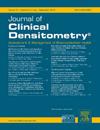Periprosthetic Bone Mineral Density Change after Total Knee Arthroplasty in Vietnamese Population
IF 1.6
4区 医学
Q4 ENDOCRINOLOGY & METABOLISM
引用次数: 0
Abstract
Objectives: After total knee arthroplasty (TKA), bone structure changes around prosthetics gradually appear. Adverse changes, such as decreased bone mineral density (BMD) and bone remodeling, can lead to joint loosening, affecting surgical outcomes. The study aims to detect BMD changes in the bone around the artificial knee early after TKA.
Methods: We performed a prospectively descriptive study on 54 patients who were operated at Viet Duc University Hospital from 4/2017 to 4/2019. Bone density was measured using dual-energy X-ray absorptiometry (DEXA) at the seventh days, 3,6,12, and 24 months post-surgery.
Results: The BMD in the medial metaphyseal region of interest decreased by 10.36 %, 11.5 %, 11.88 %, and 12.13 % at 3, 6, 12, and 24 months respectively, compared to 7 days post-surgery. The lateral metaphyseal region of interest decreased by 6.09 %, 6.47 %, 6.97 %, and 7.1 % and the tibial diaphyseal region of interest decreased by 3.75 %, 4.66 %, 5.91 %, and 5.8 % over the same follow-up periods. The BMD in the femoral condyle region of interest decreased by 8.15 %, 8.62 %, 9.24 %, and 10.65 % compared to the corresponding 7-day period at 3,6,12, and 24 months post-surgery.
Conclusion: The periprosthetic BMD rapidly reduced in the first 3 months, then gradually decreased. After 24 months of follow-up, the BMD in the medial metaphyseal region of interest decreased the most.
越南人口全膝关节置换术后假体周围骨矿物质密度的变化
目的:全膝关节置换术后,假体周围骨结构的变化逐渐显现。不利的变化,如骨密度(BMD)降低和骨重塑,可导致关节松动,影响手术结果。本研究旨在检测膝关节置换术后早期人工膝关节周围骨的骨密度变化。方法:对2017年4月至2019年4月在越南大学医院手术的54例患者进行前瞻性描述性研究。术后第7天、3、6、12、24个月采用双能x线骨密度仪(DEXA)测量骨密度。结果:与术后7天相比,内侧干骺端感兴趣区骨密度在术后3、6、12和24个月分别下降了10.36 %、11.5 %、11.88 %和12.13 %。在相同的随访期间,外侧干骺端感兴趣区分别减少了6.09 %、6.47 %、6.97 %和7.1 %,胫骨干骺端感兴趣区分别减少了3.75 %、4.66 %、5.91 %和5.8 %。与术后3、6、12和24个月相应的7天时间相比,股骨髁感兴趣区域的BMD分别下降了8.15% %、8.62% %、9.24% %和10.65 %。结论:假体周围骨密度在前3个月迅速下降,随后逐渐下降。随访24个月后,内侧干骺端感兴趣区域的骨密度下降最多。
本文章由计算机程序翻译,如有差异,请以英文原文为准。
求助全文
约1分钟内获得全文
求助全文
来源期刊

Journal of Clinical Densitometry
医学-内分泌学与代谢
CiteScore
4.90
自引率
8.00%
发文量
92
审稿时长
90 days
期刊介绍:
The Journal is committed to serving ISCD''s mission - the education of heterogenous physician specialties and technologists who are involved in the clinical assessment of skeletal health. The focus of JCD is bone mass measurement, including epidemiology of bone mass, how drugs and diseases alter bone mass, new techniques and quality assurance in bone mass imaging technologies, and bone mass health/economics.
Combining high quality research and review articles with sound, practice-oriented advice, JCD meets the diverse diagnostic and management needs of radiologists, endocrinologists, nephrologists, rheumatologists, gynecologists, family physicians, internists, and technologists whose patients require diagnostic clinical densitometry for therapeutic management.
 求助内容:
求助内容: 应助结果提醒方式:
应助结果提醒方式:


